I am writing this to explain my feelings about RRP
One Person’s Opinion: This is a guest blog submitted by Joe Levitch of Levco Builders to express his opinion. Joe is a remodeling contractor and he is also a Licensed Lead Inspector and the owner of Lead Locators, a lead inspection firm in Boise Idaho. He comments and contributes to RRPedia quite often. If you would like to express your opinion or offer something of value for RRPedia visitors let me know.
I am writing this to explain my feelings about RRP
There is a wide spectrum of folks who have been affected by the RRP rule from carpenters with a pickup and a dog, to multimillion dollar companies. Not all trades have the same challenges. I believe the painters have it the worst of all with their vertical containment issues and the concern of using ladders over plastic covered surfaces. However, since RRP is a blanket rule for all trades, I suggest we all need to be involved in collectively solving each other’s dilemmas.
 How we all choose to respond to the EPA’s oversight of the remodeling industry is a personal one. I will be the first to admit that initially I found it difficult to understand how invisible dust particles can cause serious health hazards. But with a little research, I got it. I suggest you can understand it too. Take my word for it, or look it up. I’m sure you will come to the same conclusion.
How we all choose to respond to the EPA’s oversight of the remodeling industry is a personal one. I will be the first to admit that initially I found it difficult to understand how invisible dust particles can cause serious health hazards. But with a little research, I got it. I suggest you can understand it too. Take my word for it, or look it up. I’m sure you will come to the same conclusion.
Not everyone wants to have a real business. I often describe that my business was akin to “A Lemonade Stand” (Not that I don’t like them in fact I have a family rule that it is illegal to pass one up without stopping). I have evolved it into a real business and have accepted the responsibilities that go along with it. My big step forward occurred when I joined NARI.
 The business part turns me on right now. However, I understand that there are those who prefer the hands on, the nail gun and the saw. I happen to prefer the keyboard and the pen. Having this new RRP rule is a huge challenge to incorporate into any business and I feel many of the same pressures you do. I believe following the rules and separating my business from others will take me to the next level of success. I also understand there are those who are seeing it from a totally different perspective.
The business part turns me on right now. However, I understand that there are those who prefer the hands on, the nail gun and the saw. I happen to prefer the keyboard and the pen. Having this new RRP rule is a huge challenge to incorporate into any business and I feel many of the same pressures you do. I believe following the rules and separating my business from others will take me to the next level of success. I also understand there are those who are seeing it from a totally different perspective.
It reminds me of an old story from India about the six blind men that were asked to touch a different part of an elephant and describe what an elephant looks like. The man that touched the leg said it is like a pillar. The man that touched the tail said an elephant is like a rope; and so on. The truth is that each man is absolutely correct. Only the sighted person can see what the elephant looks like as a whole.
From the perspective of a carpenter the RRP rule is a pain in the butt. From the homeowner’s perspective, it is a way to keep her kids safer, and it jacks up the price for remodeling. From many professional remodelers’ perspectives, the RRP rule is another level of certification and a credential that sets them apart from the competition. No matter how you look at RRP, it is a new requirement and changes the game we were all used to.
As an industry I would like us to see us move to the fifth step in the Kübler-Ross model made famous in her 1969 book, On Death and Dying.
- Denial= “ I feel fine, this can’t be happening to me“ (This was done prior to 4-22-2010)
- Anger =”Why me?” (Lots of this still floating around)
- Bargaining= “Just let me do it the way we always have… I did a fine job of cleaning.” (Some professional organizations are still lobbying for this.)
- Depression= “I am so sad, why do I even bother?” (A whole lot of us are dealing with this)
- Acceptance= “It’s going to be okay, I can do this thing” (Most larger companies and some of the rest are well on the way to incorporating the RRP rule into their marketing strategies)
 There is a sufficient body of scientific evidence that lead dust is created during renovation and while disturbing lead based painted surfaces. There is also a significant body of medical knowledge that lead is bad for people. I am educating my perspective clients as fast as I can. To the extent that they get it, and see a value in what I offer, I will be a clear choice for those who live in Pre 1978 homes.
There is a sufficient body of scientific evidence that lead dust is created during renovation and while disturbing lead based painted surfaces. There is also a significant body of medical knowledge that lead is bad for people. I am educating my perspective clients as fast as I can. To the extent that they get it, and see a value in what I offer, I will be a clear choice for those who live in Pre 1978 homes.
For those among us that have made it to the fifth level, I would like to open a national discussion about how we are coping with the challenges and succeeding. The East coast has been dealing with these issues for a lot longer that the West. Shawn has been gracious enough to share the stage for a moment and see if the concept gains traction. My goal is to plant the seed.

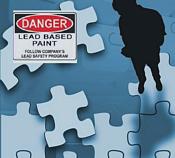 Looking for accurate information about the EPA RRP rule?
Looking for accurate information about the EPA RRP rule? 

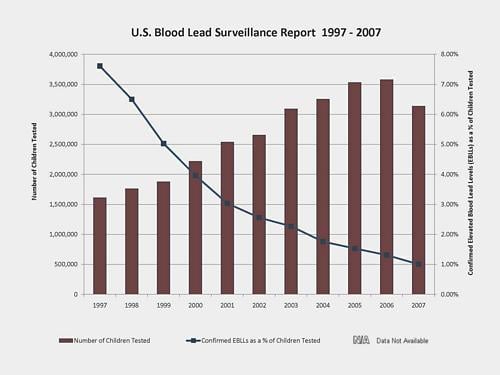
 In a document dated December 1998 EPA received a
In a document dated December 1998 EPA received a  How bad is the child lead poisoning problem? And, how many of the poisoned children were poisoned by lead due to renovation work? The answer to these two simple questions might surprise you. Had the EPA and Congress done adequate research, might they have found better and more cost effective ways to further reduce the number of lead poisoned children?
How bad is the child lead poisoning problem? And, how many of the poisoned children were poisoned by lead due to renovation work? The answer to these two simple questions might surprise you. Had the EPA and Congress done adequate research, might they have found better and more cost effective ways to further reduce the number of lead poisoned children?  No child should be poisoned by lead. However, our government and politicians are concentrating in the wrong area if they really want to substantially address the lead poisoning problem. As I had discussed in a
No child should be poisoned by lead. However, our government and politicians are concentrating in the wrong area if they really want to substantially address the lead poisoning problem. As I had discussed in a  While at the workshop I found one thing the main instructor Darcy Cook of Safety Trainers said to be very important for contractors to be aware of. Under the OSHA Lead in Construction Standard, contractors must assume their employees will be exposed to lead above OSHA’s established action level requiring the use of respirators until they actually conduct air monitoring testing to prove otherwise.
While at the workshop I found one thing the main instructor Darcy Cook of Safety Trainers said to be very important for contractors to be aware of. Under the OSHA Lead in Construction Standard, contractors must assume their employees will be exposed to lead above OSHA’s established action level requiring the use of respirators until they actually conduct air monitoring testing to prove otherwise.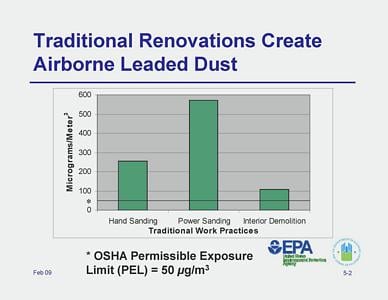
 So, under OSHA requirements, before allowing them to do RRP related work or even enter a contained work area, employees must first be sent to a physician to be sure they are healthy enough to wear a respirator. Then they must be fit tested by a professional and provided with a properly fitted respirator that protects them from worst case lead exposure scenarios based on the kind of work they do. They must also be trained how to select, use, clean and store a respirator. And, they must wear the respirator until the air monitoring testing is done to identify when a respirator is required and when it is not depending on how the work is performed and what engineering controls are being used.
So, under OSHA requirements, before allowing them to do RRP related work or even enter a contained work area, employees must first be sent to a physician to be sure they are healthy enough to wear a respirator. Then they must be fit tested by a professional and provided with a properly fitted respirator that protects them from worst case lead exposure scenarios based on the kind of work they do. They must also be trained how to select, use, clean and store a respirator. And, they must wear the respirator until the air monitoring testing is done to identify when a respirator is required and when it is not depending on how the work is performed and what engineering controls are being used. Renovators should be aware that in addition to EPA or administering states, other individuals or entities may likely take advantage of the documentation requirements to hold renovators accountable for their actions or lack thereof.
Renovators should be aware that in addition to EPA or administering states, other individuals or entities may likely take advantage of the documentation requirements to hold renovators accountable for their actions or lack thereof. OSHA could use RRP paperwork to prove non-compliance with its Lead in Construction Standards. OSHA’s worker protection requirements related to lead are very specific. Information contained in the required RRP documentation, particularly the renovation checklist and non-certified worker training documentation, could easily be used to show workers were not adequately trained and or protected when working in contained work areas. A lack of the required documentation could also be used by OSHA to demonstrate negligence by the business.
OSHA could use RRP paperwork to prove non-compliance with its Lead in Construction Standards. OSHA’s worker protection requirements related to lead are very specific. Information contained in the required RRP documentation, particularly the renovation checklist and non-certified worker training documentation, could easily be used to show workers were not adequately trained and or protected when working in contained work areas. A lack of the required documentation could also be used by OSHA to demonstrate negligence by the business. 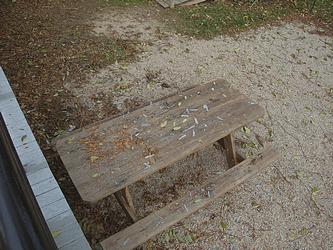
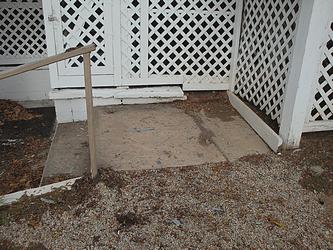 This is an excellent observation and question. The liability in such a situation is huge. I just recently had a conversation about this topic with an attorney well familiar with the RRP rule. Her suggestion was to consider asking the home owner to do testing of the occupants and perhaps even dust wipe testing at the home before beginning any work to establish a point of reference. Discussing this with and asking the home owner to do so would obviously be a sensitive conversation and could likely be a tough sell for many contractors.
This is an excellent observation and question. The liability in such a situation is huge. I just recently had a conversation about this topic with an attorney well familiar with the RRP rule. Her suggestion was to consider asking the home owner to do testing of the occupants and perhaps even dust wipe testing at the home before beginning any work to establish a point of reference. Discussing this with and asking the home owner to do so would obviously be a sensitive conversation and could likely be a tough sell for many contractors.
 Many RRPedia users, attendees of my seminars about the RRP Rule and a few others at several RRP workshops I have participated at have asked what should be done if someone has been poisoned by lead. Perhaps you might even know a carpenter poisoned by lead. I am not an expert in this area but thought it would be helpful to do some research and offer some guidance on what to do if affected by lead poisoning. You can find out about the symptoms of lead poisoning by reading this
Many RRPedia users, attendees of my seminars about the RRP Rule and a few others at several RRP workshops I have participated at have asked what should be done if someone has been poisoned by lead. Perhaps you might even know a carpenter poisoned by lead. I am not an expert in this area but thought it would be helpful to do some research and offer some guidance on what to do if affected by lead poisoning. You can find out about the symptoms of lead poisoning by reading this  Lead poisoning occurs in children and adults when lead builds up in their bodies, often over months or years. It is important to know that even small amounts of lead can cause serious health problems and possibly long term effects. Children under the age of 6 are especially vulnerable to lead poisoning, but adults, particularly those who do RRP related work can suffer serious consequences due to long term and or multiple exposures. At very high levels of exposure, lead poisoning can be fatal.
Lead poisoning occurs in children and adults when lead builds up in their bodies, often over months or years. It is important to know that even small amounts of lead can cause serious health problems and possibly long term effects. Children under the age of 6 are especially vulnerable to lead poisoning, but adults, particularly those who do RRP related work can suffer serious consequences due to long term and or multiple exposures. At very high levels of exposure, lead poisoning can be fatal. For more severe cases of lead poisoning, your doctor may recommend treatments such as Chelation therapy or EDTA therapy. Chelation therapy is a treatment that includes taking a medication that binds with the lead in your body and is eventually excreted in your urine. EDTA therapy is typically used for more serious cases. This treatment includes treating the patient’s blood with a chemical called ethylenediaminetetraacetic acid (EDTA). Depending on the patient’s blood lead level, more than one treatment may be required. Unfortunately, in severe cases, it may not be possible to reverse damage that has already occurred. Children with lead toxicity may also be iron deficient and can be treated with iron supplements.
For more severe cases of lead poisoning, your doctor may recommend treatments such as Chelation therapy or EDTA therapy. Chelation therapy is a treatment that includes taking a medication that binds with the lead in your body and is eventually excreted in your urine. EDTA therapy is typically used for more serious cases. This treatment includes treating the patient’s blood with a chemical called ethylenediaminetetraacetic acid (EDTA). Depending on the patient’s blood lead level, more than one treatment may be required. Unfortunately, in severe cases, it may not be possible to reverse damage that has already occurred. Children with lead toxicity may also be iron deficient and can be treated with iron supplements.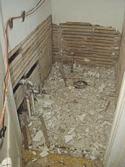 According to
According to  Although I agree renovators should be required to work lead-safe, I suggest that the RRP rule falls way too short in preventing lead poisoning. Allowing home owners and tenants to do RRP work without the knowledge and proper training required should be considered a travesty. Without understanding how lead poisoning happens and how to perform the work in a lead-safe manner, these parents are often unknowingly poisoning their children.
Although I agree renovators should be required to work lead-safe, I suggest that the RRP rule falls way too short in preventing lead poisoning. Allowing home owners and tenants to do RRP work without the knowledge and proper training required should be considered a travesty. Without understanding how lead poisoning happens and how to perform the work in a lead-safe manner, these parents are often unknowingly poisoning their children. The EPA sent out the press release below to announce National Lead Poisoning Prevention Week. Although the announcement mentions the RRP Rule and that contractor training and certification are required, it certainly falls short in giving consumers sound advice about having renovations done at their homes. Earlier this year many in the industry expressed this same concern about the
The EPA sent out the press release below to announce National Lead Poisoning Prevention Week. Although the announcement mentions the RRP Rule and that contractor training and certification are required, it certainly falls short in giving consumers sound advice about having renovations done at their homes. Earlier this year many in the industry expressed this same concern about the  Legitimate businesses have been demanding that EPA enforce the rule and go after illegally operating renovators. This announcement could have assisted in that effort. Had the announcement encouraged consumers to check for and report violators of the rule perhaps we could protect more children. In effect, by not adequately enforcing this rule, the gap between legitimate businesses and the underground economy is widening.
Legitimate businesses have been demanding that EPA enforce the rule and go after illegally operating renovators. This announcement could have assisted in that effort. Had the announcement encouraged consumers to check for and report violators of the rule perhaps we could protect more children. In effect, by not adequately enforcing this rule, the gap between legitimate businesses and the underground economy is widening. 



